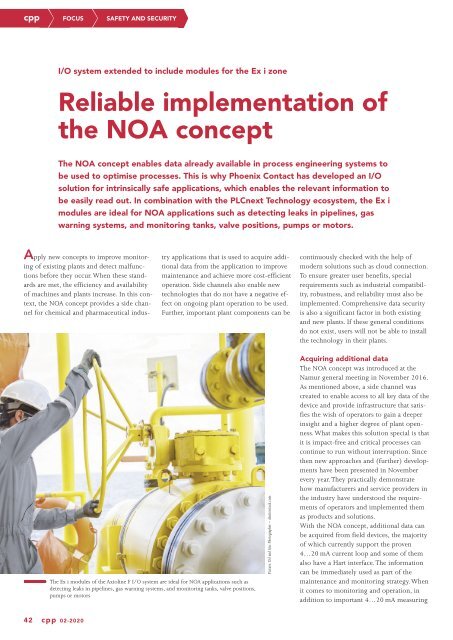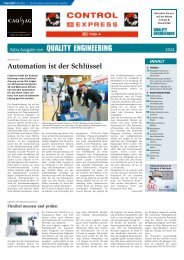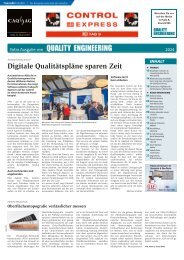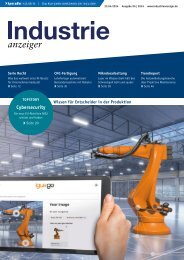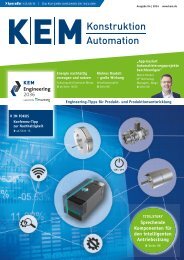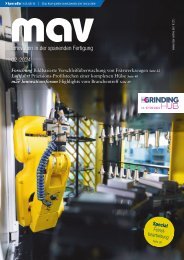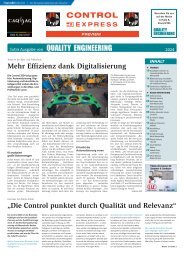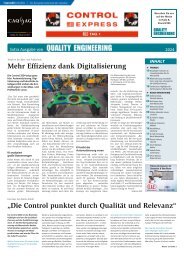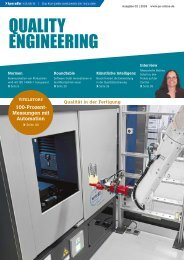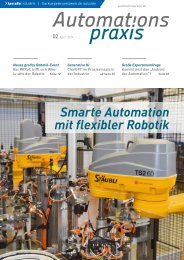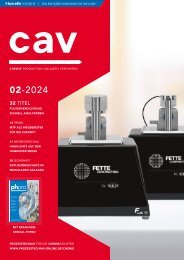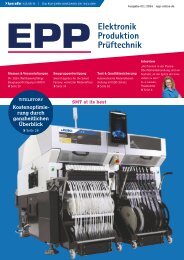cpp – Process technology for the chemical industry 02.2020
The journal cpp - Process technology for the chemical industry reports about processes, plants, apparatus and components for the chemical and pharmaceutical industry. Further topics are IT technologies, industry 4.0, digital production, MSR and automation technology and process analysis technology. The content spectrum is rounded off by explosion protection, plant safety, occupational health and safety, maintenance, site management and energy management.
The journal cpp - Process technology for the chemical industry reports about processes, plants, apparatus and components for the chemical and pharmaceutical industry. Further topics are IT technologies, industry 4.0, digital production, MSR and automation technology and process analysis technology. The content spectrum is rounded off by explosion protection, plant safety, occupational health and safety, maintenance, site management and energy management.
Create successful ePaper yourself
Turn your PDF publications into a flip-book with our unique Google optimized e-Paper software.
<strong>cpp</strong> FOCUS SAFETY AND SECURITY<br />
I/O system extended to include modules <strong>for</strong> <strong>the</strong> Ex i zone<br />
Reliable implementation of<br />
<strong>the</strong> NOA concept<br />
The NOA concept enables data already available in process engineering systems to<br />
be used to optimise processes. This is why Phoenix Contact has developed an I/O<br />
solution <strong>for</strong> intrinsically safe applications, which enables <strong>the</strong> relevant in<strong>for</strong>mation to<br />
be easily read out. In combination with <strong>the</strong> PLCnext Technology ecosystem, <strong>the</strong> Ex i<br />
modules are ideal <strong>for</strong> NOA applications such as detecting leaks in pipelines, gas<br />
warning systems, and monitoring tanks, valve positions, pumps or motors.<br />
Apply new concepts to improve monitoring<br />
of existing plants and detect malfunctions<br />
be<strong>for</strong>e <strong>the</strong>y occur. When <strong>the</strong>se stand -<br />
ards are met, <strong>the</strong> efficiency and availability<br />
of machines and plants increase. In this context,<br />
<strong>the</strong> NOA concept provides a side channel<br />
<strong>for</strong> <strong>chemical</strong> and pharmaceutical <strong>industry</strong><br />
applications that is used to acquire additional<br />
data from <strong>the</strong> application to improve<br />
maintenance and achieve more cost-efficient<br />
operation. Side channels also enable new<br />
technologies that do not have a negative effect<br />
on ongoing plant operation to be used.<br />
Fur<strong>the</strong>r, important plant components can be<br />
continuously checked with <strong>the</strong> help of<br />
modern solutions such as cloud connection.<br />
To ensure greater user benefits, special<br />
requirements such as industrial compatibility,<br />
robustness, and reliability must also be<br />
implemented. Comprehensive data security<br />
is also a significant factor in both existing<br />
and new plants. If <strong>the</strong>se general conditions<br />
do not exist, users will not be able to install<br />
<strong>the</strong> <strong>technology</strong> in <strong>the</strong>ir plants.<br />
The Ex i modules of <strong>the</strong> Axioline F I/O system are ideal <strong>for</strong> NOA applications such as<br />
detecting leaks in pipelines, gas warning systems, and monitoring tanks, valve positions,<br />
pumps or motors<br />
Picture: Oil and Gas Photographer <strong>–</strong> shutterstock.com<br />
Acquiring additional data<br />
The NOA concept was introduced at <strong>the</strong><br />
Namur general meeting in November 2016.<br />
As mentioned above, a side channel was<br />
created to enable access to all key data of <strong>the</strong><br />
device and provide infrastructure that satisfies<br />
<strong>the</strong> wish of operators to gain a deeper<br />
insight and a higher degree of plant openness.<br />
What makes this solution special is that<br />
it is impact-free and critical processes can<br />
continue to run without interruption. Since<br />
<strong>the</strong>n new approaches and (fur<strong>the</strong>r) developments<br />
have been presented in November<br />
every year. They practically demonstrate<br />
how manufacturers and service providers in<br />
<strong>the</strong> <strong>industry</strong> have understood <strong>the</strong> requirements<br />
of operators and implemented <strong>the</strong>m<br />
as products and solutions.<br />
With <strong>the</strong> NOA concept, additional data can<br />
be acquired from field devices, <strong>the</strong> majority<br />
of which currently support <strong>the</strong> proven<br />
4…20 mA current loop and some of <strong>the</strong>m<br />
also have a Hart interface. The in<strong>for</strong>mation<br />
can be immediately used as part of <strong>the</strong><br />
maintenance and monitoring strategy. When<br />
it comes to monitoring and operation, in<br />
addition to important 4…20 mA measuring<br />
42 <strong>cpp</strong> 02-2020


